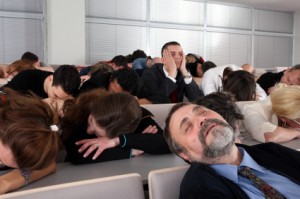Public speaking is a great way for lawyers to build their reputation and meet new contacts. But great material isn’t enough to make a great presentation. You have to deliver that material with a great performance.
The first rule of public speaking is displaying good energy. You may be passionate about your subject matter but unless you transfer that emotion to the audience, through your words, tone of voice, and body language, your message won’t get through.
I’ve had to work on this myself. I recall a time about ten years ago I gave a presentation and when I got off stage I asked my co-presenter what he thought about my talk. He said, “Do you drink coffee?” When I said I did, he told me I should drink more.
If you do any live presentations (or want to), here are a few tips for doing a better presentation:
- Don’t attempt to teach your audience everything. A few key points is all you need and all anyone can handle.
- Never tell “the history of” anything. Get to the point: what do I need to know right now?
- If you use slides, don’t cram them with text. A few lines with a few words each.
- Speak into the microphone and project your voice to the back of the room. Nobody will hear you or understand you if you sound like Charlie Brown’s teacher.
- Modulate your voice. Use a mixture of highs and lows, fast and slow pace.
- Talk to the audience, not at them. Ask questions, tell stories, say something unusual or funny.
- Make eye contact with as many people as you can. Use their names if you know them or you can read their name tags.
- Don’t just stand there, move. Walk around, gesture, throw something (just kidding).
- Keep it short. Twenty minutes is about all anyone can handle before their mind wanders.
- Tell them what to do next. Give them a web site and tell them what to do when they get there. Offer something in return for their business card. Or give them a homework assignment.
- Thank your hosts, thank the audience, and thank God nobody fell asleep.
I’m certainly not the best speaker in the world. But I’m better today than I was last year and I’ll be better next year than I am this year. Speaking is a skill and it can be learned. Practice, get feedback, and practice some more.
Being an attorney will get you asked to speak. Being a good speaker will get you asked back.
Want more ways to build your reputation? Here’s The Formula.








